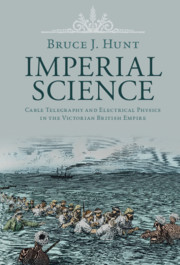Book contents
- Imperial Science
- Science in History
- Imperial Science
- Copyright page
- Contents
- Figures
- Acknowledgments
- Abbreviations
- Prologue: “An Imperial Science”
- 1 “An Ill-Understood Effect of Induction”
- 2 Wildman Whitehouse, William Thomson, and the First Atlantic Cable
- 3 Redeeming Failure
- 4 Units and Standards
- 5 The Ohm, the Speed of Light, and Maxwell’s Theory of the Electromagnetic Field
- 6 To Rule the Waves
- Epilogue Full Circle
- Bibliography
- Index
1 - “An Ill-Understood Effect of Induction”
Telegraphy and Field Theory in Victorian Britain
Published online by Cambridge University Press: 11 December 2020
- Imperial Science
- Science in History
- Imperial Science
- Copyright page
- Contents
- Figures
- Acknowledgments
- Abbreviations
- Prologue: “An Imperial Science”
- 1 “An Ill-Understood Effect of Induction”
- 2 Wildman Whitehouse, William Thomson, and the First Atlantic Cable
- 3 Redeeming Failure
- 4 Units and Standards
- 5 The Ohm, the Speed of Light, and Maxwell’s Theory of the Electromagnetic Field
- 6 To Rule the Waves
- Epilogue Full Circle
- Bibliography
- Index
Summary
"When the first underground and submarine telegraph cables were laid around 1850, engineers noticed that sharp signals sent in at one end emerged at the other badly blurred and appreciably delayed. This “retardation” grew worse on longer cables and threatened to make operation of the proposed 2000-mile Atlantic line unprofitably slow. Retardation presented British physicists and engineers with both an intriguing physical phenomenon and a serious practical problem, and they studied it closely from the 1850s on.
Latimer Clark, a prominent British cable engineer, brought retardation to Michael Faraday’s attention late in 1853, and Faraday’s published account of the phenomenon served to publicize both retardation and the ideas about the electromagnetic field that he invoked to explain it. Faraday’s paper led William Thomson (later Lord Kelvin) to reprint two papers on field theory he had written in the 1840s, and later in 1854 a related cable question prompted Thomson to work out what became the accepted mathematical theory of signal transmission. Moreover, it was at just this time, and largely under Thomson’s guidance, that James Clerk Maxwell first took up the study of electricity, with results that were to transform electromagnetic theory."
Keywords
- Type
- Chapter
- Information
- Imperial ScienceCable Telegraphy and Electrical Physics in the Victorian British Empire, pp. 3 - 36Publisher: Cambridge University PressPrint publication year: 2021

